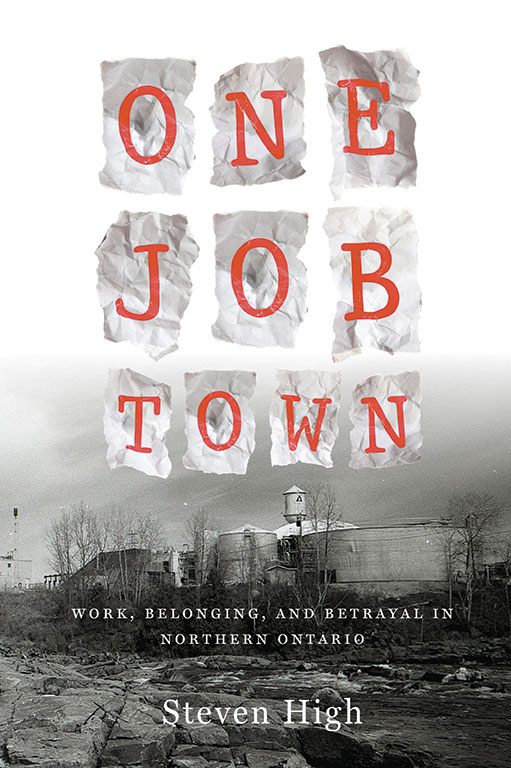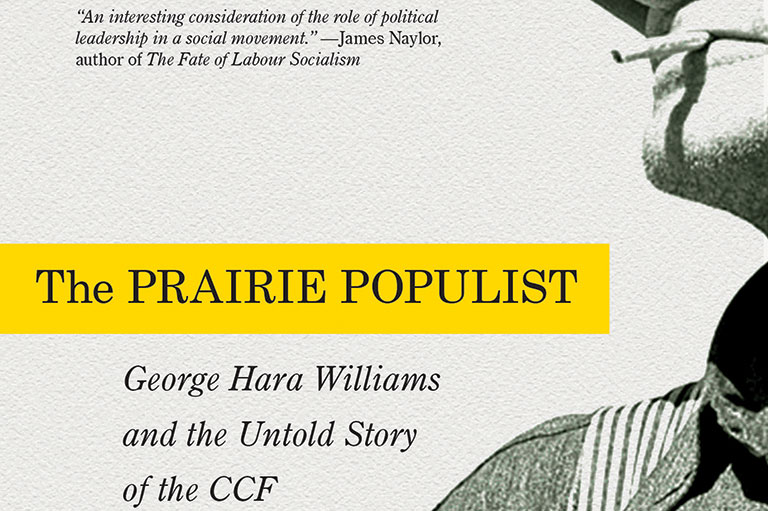One Job Town

One Job Town: Work, Belonging, and Betrayal in Northern Ontario
by Steven High
University of Toronto Press, 392 pages, $39.95
Today, the working lives of many Canadians are defined by long commutes, high-rise towers, and encountering throngs of anonymous faces on the way to the office. There was a time, however, when a good number of the country’s labourers had their daily routines marked by the high pitch of their mill’s shift whistle, the exchange of friendly greetings to their familial co-workers, and the sight — and sometimes-ghastly smell — of steam rising from their factory’s chimney.
Steven High makes the disappearance from the Canadian landscape of one of those industrial plants — the pulp and paper mill in Sturgeon Falls, Ontario — the subject of his latest book, One Job Town: Work, Belonging, and Betrayal in Northern Ontario.
The book is built upon the traditional documentary evidence historians have long tapped, but more importantly it is founded on a treasure trove of oral interviews that High and several local students conducted with former mill employees.
The mill itself serves merely as the backdrop to High’s story, so he retells this aspect of the tale in relatively short order.
Constructed in 1898 to tap the region’s supply of pulpwood, it sputtered during its nascent years, endured several long closures (including from 1904 to 1912 and from 1930 to 1947), enjoyed a relatively prolonged golden period after the Second World War, and then began a slow yet steady decline in 1969 when one of its lines closed.
In total, six firms owned the mill, with the final one — Weyerhaeuser, an American behemoth — making the decision in 2002 to close the plant permanently and, thereafter, to demolish it and to shred practically all its archival records.
High devotes the bulk of his book to the memories the mill’s former employees hold about the industrial culture they created and how they endured its destruction.
Although historians, High included, have recounted similar stories before, he is perhaps the first to focus on how this process played out on the “resource periphery” in Northern Ontario. In casting a spotlight on Sturgeon Falls, he stresses the political relations that pervaded all aspects of work for those who toiled in the town’s relatively small pulp and paper mill.
Although formal labour disputes were remarkably rare at the plant, High repeatedly returns to the theme of “mill colonialism.” He describes how deep divisions existed and power struggles were continually fought between the largely anglophone “outsider” managerial class, that was situated symbolically upstairs in the plant, and the overwhelmingly francophone workers on the shop floor, who generally came from the local region.
High asserts that this hierarchical class struggle was exemplified by the presence until the early 1970s of a single English-language high school whose existence the company vehemently defended in the overwhelmingly francophone town. He argues that the successful battle waged by Franco-Ontarians to gain their own high school in Sturgeon Falls was an integral part of the period’s “decolonization movement” and relates it to the struggles fought during the Quiet Revolution in Quebec.
Nevertheless, High also underscores the complexity of this story. Workers were indelibly stamped with the date on which they were hired, for example, and union rules dictated that their seniority formed a permanent barrier among them. Moreover, workers may have loathed the company that owned the mill, but they deeply valued the employment it gave them because of the relatively high wages and the job security they had enjoyed.
Similarly, they tenaciously fought to preserve the mill’s history; a massive binder chronicling it survives as a testament to their pride in their erstwhile workplace. High also stresses the gaping fissures that often separated local union members from their leaders.
The book’s strength is High’s ability to tell this story from a deeply personal perspective. His use of extensive oral interviews with former employees provides intimate glimpses into the wide range of raw emotions that such traumatic events elicit.
Moreover, High openly admits that this is a story near and dear to his heart. Not only was he a professor at nearby Nipissing University both during and after the mill’s final days, he is also a native of another blue-collar city in northern Ontario — Thunder Bay — and the son of a railway worker. His deep-seated affinity for the plight of the workers and of the towns that are losing industries that have long sustained them pervades the pages of this book.
Themes associated with this article
Advertisement




